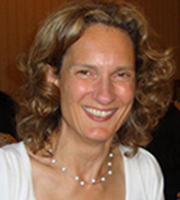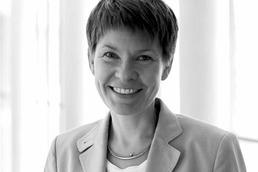Margaret May and Godela Weiss-Sussex report on this symposium held at the IMLR on 1 March 2018
 Enthusiastic participants braved the wintry weather on 1 March to discuss some of the intriguing issues arising from the concept of translingualism at a symposium convened by Dr Godela Weiss-Sussex at the IMLR. Part of the AHRC-funded Open World Research Initiative project ‘Cross-Language Dynamics – Reshaping Community’, this event was designed to test ideas for a major international conference next year on women’s translingual writing.
Enthusiastic participants braved the wintry weather on 1 March to discuss some of the intriguing issues arising from the concept of translingualism at a symposium convened by Dr Godela Weiss-Sussex at the IMLR. Part of the AHRC-funded Open World Research Initiative project ‘Cross-Language Dynamics – Reshaping Community’, this event was designed to test ideas for a major international conference next year on women’s translingual writing.
What is translingualism? Although Prof Anne Fleig (FU Berlin) commented wryly at the end of the afternoon that there is actually no equivalent word in German, the definition that emerged was that of a vector, a moving between and across languages, a process showing elements of more than one language and operating from within its own uncertainties. As Dr Weiss-Sussex explained, translingualism is not new, since it is a common exile experience, but in our times, in which migration and multilingualism are more commonplace experiences, translingual language use is often a choice, not a necessity. Rather than being seen as defective, moving beyond the monolingual paradigm provides an opportunity to express complex hybrid identities – or to resist expectations of identitarian discourse altogether.
Focusing on the detailed analysis of texts in French, Italian and German, the symposium presenters considered how various writers used specific language-enriching strategies and techniques in their translingual texts. Specifically, the questions addressed in this workshop were:
• How does the particular attention to language required in translingual writing affect the text?
• What are the distinctive literary and linguistic strategies employed in translingual writing?
• Does writing in a foreign tongue go hand in hand with establishing a new identity?
• What can translingual writing achieve that goes beyond the possibilities of texts produced by mother-tongue writers?
• What is the relationship between translingual expression and femininity?
First, participating via a Skype link, Prof Mary Gallagher (University College Dublin) examined the novelist and essayist Nancy Huston’s writing in French (a language she learned as a teenager), as well as her self-translations back into her ‘mother tongue’, English. She explored how Huston’s linguistic decisions (influenced by the childhood trauma of separation from her mother) helped to construct and define her identity as a writer, a woman and a mother herself. Prof Gallagher stressed Huston’s awareness of the empowering capacity to ‘superimpose’ different identities on one another through the use of different languages. However, she also highlighted Huston’s strong and complex connection with her ‘langue mère’, English, which continues to be a point of origin and reference for Huston’s identities as a daughter and a mother.
Anne Fleig, by contrast, started her observations by sharply critiquing the concept of the mother tongue as a construct used in t he service of nation building and the normalisation of monolingualism. Referring to the German language context specifically, Prof Fleig traced how, building on the ‘naturalising’ rhetoric of authenticity, a standardisation of language could be enforced in the late 19th century that is now being questioned and undermined in recent translingual writing, primarily by women. Analysing heteroglossia in the writings of Emine Sevgi Özdamar and Yoko Tawada – authors, respectively, of Turkish and Japanese origin who have achieved considerable literary success writing in German – Fleig highlighted the process of emancipation of the female voice in translingual texts and commented on the similarities between the experiences of women and migrant writers more generally.
he service of nation building and the normalisation of monolingualism. Referring to the German language context specifically, Prof Fleig traced how, building on the ‘naturalising’ rhetoric of authenticity, a standardisation of language could be enforced in the late 19th century that is now being questioned and undermined in recent translingual writing, primarily by women. Analysing heteroglossia in the writings of Emine Sevgi Özdamar and Yoko Tawada – authors, respectively, of Turkish and Japanese origin who have achieved considerable literary success writing in German – Fleig highlighted the process of emancipation of the female voice in translingual texts and commented on the similarities between the experiences of women and migrant writers more generally.
One of the strategies Fleig highlighted in Özdamar’s and Tawada’s writing is that of ‘queering’ the mother tongue through a polyphonic, dialogical writing style. Polyphonic writing is a characteristic also of the texts by the Somalia-born author Shirin Ramzanali Fazel. In her paper on Fazel’s novel Nuvole sull’Equatore, Dr Maria Cristina Seccia (Hull) showed how untranslated Somali words and sentences in the narrative are placed in dialogue with rather than in opposition to Italian, thus making Somali culture visible served as a form of resistance to the imposition of monolingualism, and to the amnesia about the colonial policy of deliberate neglect of mixed-race Italians.
In discussing Katja Petrowskaja’s search for a sense of belonging through the imaginative re-creation of her family’s pre-Holocaust history in Vielleicht Esther (published in German in 2014 and in English translation in January this year), Godela Weiss-Sussex emphasised the author’s embrace of ambiguity and incoherencies stemming from the unreliability of fragmentary memories in the construction of a narrative that acts as a powerful tool in reworking and preserving a traumatic past. She provided many illuminating examples of the non-native speaker’s associative approach to language, in which apparently playful punning connections reveal deeper truths of an affective response to a suppressed family history. For Petrowskaja, born in Ukraine and growing up with a Russian perspective on the Second World War, writing in German (a language that she learned in her twenties) provided the freedom of otherness and enabled her to develop the concept of a cosmopolitan, universal connectedness, an identity based not on exclusion but on commonality. Her work was shown as another form of resistance, working with dissonances, questioning and probing, often in an almost child-like way, the hidden assumptions and prejudices of language to which native speakers are oblivious.
Dr Anna-Louise Milne (University of London Institute in Paris) continued this theme by speaking about her own writing journey in French, particularly in relation to her work with non-European refugees in Paris. Indeed her emphasis from the start was on ‘writing with’ – exploring the importance of what and whom one writes with, the processes of improvisation and of chiselling and crafting – rather than on the finished text or work of translation as such. She convincingly described how important it is for democracies to foster a sustainable community of languages, and presented a mapping project with the Paris Centre for Migrant Writing and Expression on the historical associations and very different modern resonances of street and place names – another revealing strand of the symposium’s focus on the renewal of literature from the margins.
The afternoon ended with a discussion of possible future directions in the work on translingual writing by contemporary women authors. Suggestions – which will feed into the larger conference envisaged for 2019 – include further exploration of:
• a theoretical base, refining concepts of translingualism, multilingualism, writing with etc.;
• translingual writing and gender;
• the mother tongue: is it a cliché to be tested and resisted or a recourse to a concept of origin and comfort; how does it help to clarify the identities of writers as daughters and mothers?
• translingual writing and the literary market
• translingual desire
• questions of identity and belonging: multiple / hybrid / resisting expectations of identity discourse?
• translingual writing and the concept of authorship: often translingual writing is polyphonic writing; what place does the author (narrator) take?
• resistance: against the monolingual paradigm? the majority / hegemonic (?) society in which the migrant writer lives and writes? patriarchal society?
• the relationship between spoken and written language
• The question of ‘authenticity’; also: how to write accent ?
• distance as a creative element;
• the translatability of translingual writing.
Watch this space! A Call for Papers will be issued shortly.
Margaret May, MRes student, IMLR and Godela Weiss-Sussex, Reader in Modern German Literature
